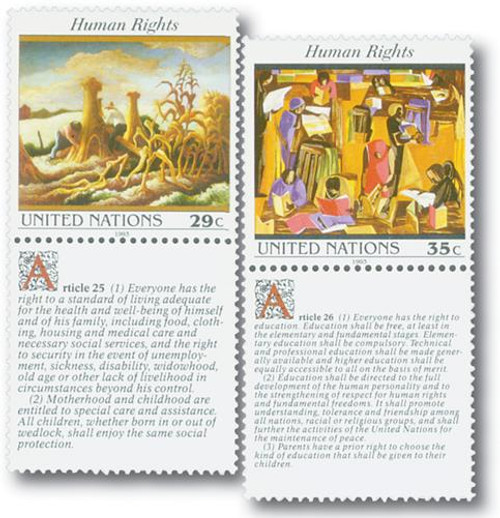
1993 Human Rights
# UNV150-51 - 1993 Human Rights
$4.25
1993 Human Rights
UN Offices in Vienna
UN Offices in Vienna
This Human Rights series ends the United Nations Postal Administration’s ambitious project of broadcasting the lofty ideals embodied in the U.N. Universal Declaration of Human Rights. Over five years, the UNPA issued 30 stamps with labels, each label detailing an article, accompanied by a related work of art.
Article 25 affirms every person’s right to a standard of living sufficient to support a meaningful, productive life. Mothers and children (whether born in or out of wedlock) are entitled to special care and acceptance. Shocking Corn (1945), by U.S.A.’s Thomas Hart Benton, depicts a version of such a vision. Article 26 mandates universal primary education consisting of academic basics and programs promoting understanding and tolerance among all nations, races, and religions. African-American Jacob Lawrence created The Library in 1960, purposely blurring his subjects’ race to spotlight education’s role in building tolerance.
Article 27 states the right of people to participate in cultural activities and benefit from scientific and technological advances. Also affirmed are the intellectual rights of creative artists and scientists. Pablo Picasso’s Three Musicians nicely supports this ideal. Article 28 affirms everyone’s right to a world order which assures the realization of the rights and freedoms set forth in the Declaration. Voice of Space (1931) by Belgian artist Rene Magritte reinforces this ideal of universal order.
Article 29 asserts that people develop their fullest potential only when their rights and freedoms have the greatest leeway. Whatever restrictions are imposed upon those rights and freedoms must be imposed solely to protect the rights and freedoms of others and to meet “...the just requirements of morality, public order and the general welfare in a democratic society.” Such a society is visible in Austrian Ferdinand G. Waldmuller’s Lower Austrian Peasants’ Wedding (1948). Humanity’s final right, Article 30, accompanied by Australian aborigine Sally Morgan’s Outback, states that no person or state can conduct business with the intent of destroying any of the rights and freedoms set forth in the U.N. Declaration.
1993 Human Rights
UN Offices in Vienna
UN Offices in Vienna
This Human Rights series ends the United Nations Postal Administration’s ambitious project of broadcasting the lofty ideals embodied in the U.N. Universal Declaration of Human Rights. Over five years, the UNPA issued 30 stamps with labels, each label detailing an article, accompanied by a related work of art.
Article 25 affirms every person’s right to a standard of living sufficient to support a meaningful, productive life. Mothers and children (whether born in or out of wedlock) are entitled to special care and acceptance. Shocking Corn (1945), by U.S.A.’s Thomas Hart Benton, depicts a version of such a vision. Article 26 mandates universal primary education consisting of academic basics and programs promoting understanding and tolerance among all nations, races, and religions. African-American Jacob Lawrence created The Library in 1960, purposely blurring his subjects’ race to spotlight education’s role in building tolerance.
Article 27 states the right of people to participate in cultural activities and benefit from scientific and technological advances. Also affirmed are the intellectual rights of creative artists and scientists. Pablo Picasso’s Three Musicians nicely supports this ideal. Article 28 affirms everyone’s right to a world order which assures the realization of the rights and freedoms set forth in the Declaration. Voice of Space (1931) by Belgian artist Rene Magritte reinforces this ideal of universal order.
Article 29 asserts that people develop their fullest potential only when their rights and freedoms have the greatest leeway. Whatever restrictions are imposed upon those rights and freedoms must be imposed solely to protect the rights and freedoms of others and to meet “...the just requirements of morality, public order and the general welfare in a democratic society.” Such a society is visible in Austrian Ferdinand G. Waldmuller’s Lower Austrian Peasants’ Wedding (1948). Humanity’s final right, Article 30, accompanied by Australian aborigine Sally Morgan’s Outback, states that no person or state can conduct business with the intent of destroying any of the rights and freedoms set forth in the U.N. Declaration.











